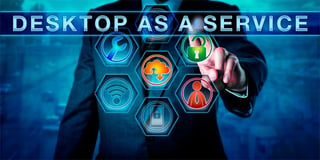 You’ve probably heard talk about virtualized desktop infrastructure (VDI) and Desktop as a Service (DaaS), but do you know what benefits it can offer your organization? While desktop virtualization isn’t a new concept, amazingly, these technologies have the power to improve user productivity and allow your team members to accomplish more at your enterprise. Read on for a look at VDI and DaaS, as well as ways you can put it to use at your company.
You’ve probably heard talk about virtualized desktop infrastructure (VDI) and Desktop as a Service (DaaS), but do you know what benefits it can offer your organization? While desktop virtualization isn’t a new concept, amazingly, these technologies have the power to improve user productivity and allow your team members to accomplish more at your enterprise. Read on for a look at VDI and DaaS, as well as ways you can put it to use at your company.
What is Desktop as a Service?
Desktop as a Service can be very helpful for organizations wanting to provide their end users with the benefits that a virtual desktop can offer. It can transform enterprises that allow and encourage BYOD, according to Computerworld. Nancy Gohring notes, “DaaS delivers virtualized desktops from the cloud; desktops can be customized for groups of workers -- say, around specific job levels or functions. Commercially available for nearly a decade, DaaS was initially intended to offload management chores and spread out the costs associated with traditional virtual desktop infrastructure (VDI).”
WATCH: To learn more about virtualized desktop solutions, watch the video below, where WEI’s Virtualization Practice Manager, Mark Gabryjelski, explains the difference between DaaS and VDI.
If you are having difficulties watching this video, click here to view it in a new window.
While the DaaS concept has been around for a while, it has only recently begun to pick up at a steady pace. As Scott Ottaway, an analyst at 451 Research found, “Desktop hosting is now a $2 billion market for cloud service providers…The market grew by 30% in the last year and should continue to grow at a similar pace through 2017.”
Because many enterprises are unable to fund VDI due to budget constraints or staffing concerns, they can employ a DaaS strategy to still gain the following benefits:
- DaaS is Cost-Effective: When compared to the implementation costs of VDI, DaaS is far more budget-friendly. IDC found DaaS can reduce hardware CAPEX by 56 percent annually. It also reduces OPEX costs.
- Tighter Security: With physical hardware, there is always an inherent security risk. If sensitive items are lost, stolen or corrupted, your organization’s information is lost, too. However, when desktops are hosted virtually, data is stored off-site and depending on your cloud provider, it can be much more secure.
- Quicker Recovery Time: If you need to restore your company’s data due to an unplanned incident, DaaS gets you back up and running quickly, due to continuous data backup and synchronization. This also helps to improve productivity in the workplace.
What is VDI?
Before DaaS, VDI has traditionally been the only way to run a desktop virtually. It runs in your data center, so users control the desktop just as they can with a physical desktop computer. VDI brings robust operational properties and transforms how the desktop is managed. A few different cloud vendors control these operations and they are trusted to be functional when your organization needs to use them.
Many organizations are able to use hyperconverged infrastructure to effectively manage VDI. IT leaders were first drawn to this framework because of its ability to support VDI environments, and now the use cases for hyperconverged infrastructure have grown as organizations have learned about other ways this solution could improve efficiencies in their data center operations.
Both DaaS and VDI solutions allow your users to pick up where they left off and get back to work quickly. They can log in anywhere from almost any device which improves productivity.
Next Steps: Learn why enterprises rely on hyperconverged infrastructure to manage their VDI environment in this infographic.











